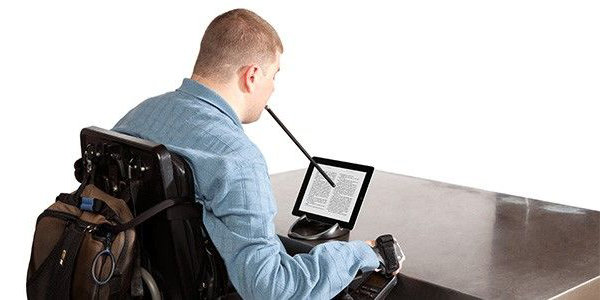2019 Jul 08
Quadriplegics can do, by themselves, many more things than most of us can realize. Even though their motor skills are heavily impaired and they have difficulties in using their upper and lower limbs, they just need the right tools to do many things that otherwise would have to be done by someone else.
In this article we focus on the humblest of all tools: the mouth stick. Many things can be done with it.
Let the them play!
There are plenty of small tasks that a person with quadriplegia can perform. Apart from the obvious, there are reasons to try and let them work and play by themselves: motivation, entertainment, self-esteem and independence, all of them play an important part in every individual’s well-being and mental health. When those are lacking, boredom and even depression may appear.
A mouth stick is an assistive device that is designed for people with uncontrolled hand movement or tremors due to cerebral palsy and for those unable to move their hands because of quadriplegia. With it they can perform activities like typing, pressing buttons, turning pages and even drawing. For that, a special stick is operated with the mouth to do a number of tasks larger than many imagine.
At one end of the stick there is usually a plastic or rubber feature that is the portion of the device that is inserted into the mouth. It makes it easier to hold the stick with the mouth, avoid harm and improve grip and control. At the other end, there is usually a rubber tip of different configurations and materials depending on the particular use intended for each stick.
Types and uses of mouth sticks
There are mouth sticks of different robustness and lengths. You can even find some telescoping mouth sticks that can be extended in length at will.
The rubber wands are usually replaceable for cleanliness and durability.
Mouse sticks can be used for several different tasks:
- Typing aid
- Page turner
- Painting and drawing
- Lifting and arranging small objects and clothes
- Pressing any kind of buttons (doorbells, TV remote, dishwashers)
- Interacting with technology (touch screens, for example)
- Pinch small objects (for this a special mouth stick with double ending in the pinching end is needed)
- Playing games
And, generally, as many things as your needs and imagination may dictate you. In this video, for example, a user demonstrates different uses for his mouth sticks.
Sufficient dexterity has to be reached to use this mouth sticks properly and many hours of practice may be needed, but with dedication it is possible to achieve a good level of autonomy for performing many different tasks that, without the mouth stick, would seem to be out of reach for a person suffering from quadriplegia.
Pros and cons of mouth sticks as assistive technology for quadriplegics
Some of the advantages of the mouth stick over other assistive technology devices are:
- It is an inexpensive object
- Versatility
- Requires training to use. Dedication and improvement may increase motivation and self-esteem.
On the other hand, some of its disadvantages are:
- It requires physical effort to use and strength in the mouth. Not everybody, at first at least, may be able to even do the simplest of tasks.
- Requires training to use. This can be an advantage (see above) but also, if the user is not previously motivated, may hinder its adoption
- It requires a lot of precision for some tasks
- Its use requires the correct distance between mouth and objects to be manipulated.
If disadvantages are more important than advantages for a particular user, it is likely that some time will need to pass until she is prepared to dedicate the effort to learn to use the mouth sticks.
In the meantime, at least for the operation of tablets and smartphones, we can offer an alternative for the use of these devices without touching the screen. Check out Mouse4all! It will make a difference in your life.


